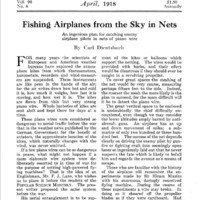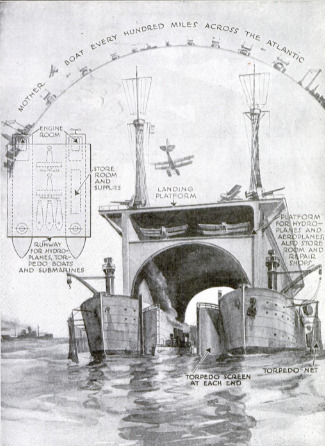-
Title (Dublin Core)
-
The mother ship
-
Article Title and/or Image Caption (Dublin Core)
-
"Mothers" for Airplanes at Sea. How the Atlantic Ocean or the war zones can be protected with relays of seaplanes
-
Caption: In the accompanying article thee writer propounds a scheme for placing one of these vessels at intervals of a hundred miles, all the way across the Atlantic. They would be fully equipped with spare parts and supplies for airplanes and submarines. They would also carry wireless apparatus and would, in fact, be fully equipped naval bases in miniature. They would repair seacraft and airplanes and would relay wireless messages , being official stations. They themselves would be protected by torpedo nets, heavy guns, and fleets of destroyers, for which they would form a base. In fact, their use in every direction is limited only by their size.
-
extracted text (Extract Text)
-
AERIAL convoys for transports and
‘merchant vessels crossing the high
seas, aerial protection for harbors,
aerial raiding bases for sea attacks, and
transoceanic aerial patrol _serviee—by
these uses of ir-craft. might perhaps be
given the vital blow to the German sub-
‘Wh not, though, airplane bases at sea?
And if at sea, why not all the way across
the Atlantic? Why not airplane stations
in and near harbors, where the craft can
be despatched, received, overhauled, and
refitted? Why not, in other words, not
only a maximum of serial coast defense
but an open sea lane, patrolled day and
night by planes?
Such a cross.sen lane is not as vet
needed, perhaps. But the lane could be
extended from English and continental
chores as far as required to give ample
protection within the operating zone of
the German submarines.
What propose here is the adaptation
of a German idea that of the “mother
ship” for submersible to the airplane, at
the same time retaining the protective and
repair value for submarines and destroyers
embodied in the Teuton ship; with the
further expansion of the use of these
double vessels on the open sea where they
can be utilized as starting and receiving
points for aerial patrols, for light ships,
for relay wireless stations, for defense
points against torpedo raids.
"Take then, by way of summary of this
plan, to separate huls, so connected by
superstructure as to form one boat with
two bottoms. Two sets of engines and
double’ rudders would provide for the
handling of this double-hull ship.
“The superstructure above these, hulls
may be most briefly described as a “plat-
form” a deck of extreme width and
length, from which air craft could be
Taunched and, in some instances, received.
Between the hulls is a natural harbor,
the water of which is made calm by the
Towering of end gates to keep out the
waves. From beneath the upper “plat. |
form,” or deck, hangs a false deck which
may be lowered into the water. This |
lowered deck and the end gates form,
with the hulls, a huge tank into which |
hydro-airplanes can descend, and by |
means of which they may be clevated to
the upper deck for overhauling. Simi |
larly submersibles, destroyers, and small
water eraft can be driven into this pro-
tective space and taken out of water for
repairs and scraping.
‘The stationing of such “mother ships”
at intervals of, say, a hundred miles all the
way across the Atlantic would provide an
open lane for transports and merchant
men. One hundred miles an hour may |
be given as an average speed, all weathers
and models considered, for an airplane.
These stations, then, would be but an
hour apart by air route. Atno time would
any airplane patrolling from one station
to another be more than hall an hour's
ride from another.
Constant patrolling by aerial routes |
from one station to another would keep
the sea clear of under-water raiders.
Communication would be so rapid, dis-
cernment so easy, that the submarine
would be less deadly than it has proven to
be. The air could be kept filled with the
flying scouts, passing from station to sta-
tion, one hundred miles and return, with
communication maintained by wireless,
not only between airplane and floating
arbor, but between the stations them
Once a periscope has been sighted any-
where within radius of the sea lane, |
general knowledge of it is known; and
from the “mother ships” debouch a fleet
of destroyers.
For the protection of the “mother
ships” torpedo nets would be provided.
Besides there are the accompanying de- |
stroyers, the “mother ship's” own heavy
artillery and munitions. It would be a
rash submersible navigator who would in-
Vade the precinets of such a lane.
-
Contributor (Dublin Core)
-
A. L. Aldey (inventor and writer)
-
Language (Dublin Core)
-
eng
-
Date Issued (Dublin Core)
-
1918-04
-
pages (Bibliographic Ontology)
-
590-591
-
Rights (Dublin Core)
-
Public Domain (Google digitized)
-
Archived by (Dublin Core)
-
Filippo Valle
-
Alberto Bordignon (Supervisor)
 Popular Science Monthly, v. 92, n. 4, 1918
Popular Science Monthly, v. 92, n. 4, 1918



